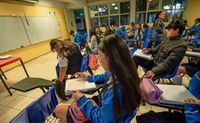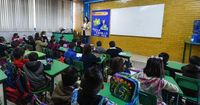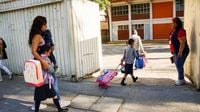The Secretaría de Educación Pública (SEP) has confirmed that classes will not be held on Thursday, May 1, 2025, and Monday, May 5, 2025, across basic education schools in Mexico, including Puebla. The academic activities will be suspended on May 1 for International Labor Day, a mandatory holiday in Mexico. Following that, classes will also be suspended on May 5 in commemoration of the historic Battle of Puebla, a significant date for the state of Puebla.
However, the SEP clarified that Friday, May 2, 2025, is not an official suspension day. This means that students are expected to attend school as usual on that day. Parents are advised to remain attentive to any specific announcements from their respective schools regarding planned activities for May 2.
In Puebla, the local government is launching the "Programa Estaciónate Aquí" on May 2, aimed at improving mobility in the capital. This program will provide access to over 9,000 parking spaces in the Historic Center and various corridors, including Carmen–Huexotitla, Chulavista–Volcanes, and Juárez–Santiago. Users can register through a mobile app, SMS, or WhatsApp, and the first three hours of parking will be free. After that, a fee of $10.00 will be charged for each additional hour.
Moreover, users who register their vehicles within the first 15 minutes will receive insurance against total theft, damage, and broken windows, with coverage up to five thousand pesos and a 20% deductible. The program includes designated spaces for people with disabilities and pregnant women, as well as special permits for residents without garages. Operating hours will be Monday to Friday from 8:00 a.m. to 10:00 p.m. and on weekends from 11:00 a.m. to 7:00 p.m. in the Historic Center.
In another concerning development, a recent armed robbery occurred on public transportation in Puebla, where criminals boarded a bus near the Motel Faraón and threatened passengers to hand over their belongings. Authorities have called for public assistance in identifying the suspects involved in this robbery.
On a cultural note, the Comisión de Derechos Humanos del Estado de Puebla (CDH Puebla) and the Centro INAH Puebla recently presented two books focusing on the historical memory and cultural identity of San Francisco Totimehuacán. The works, titled "Tepalcayotl-Totimehuacán. Derecho Humano a la Memoria Histórica e Identidad Cultural (2023)" and "De Totimehuacán a Tepalcayotl: Perspectivas para su Historiografía (2024)," were developed in response to community concerns over the preservation of the Tepalcayotl archaeological site.
During the presentation, various officials and community members reflected on the importance of safeguarding historical memory and cultural identity, reaffirming their commitment to protecting cultural rights.
As for the situation in the State of Mexico, the Sindicato de Maestros al Servicio del Estado de México (SMSEM) did not announce the liberation of Friday, May 2, 2025, indicating that classes will proceed as scheduled. During an event for International Labor Day, teachers had hoped for an announcement regarding the liberation of May 2, May 9, and May 16, but no such announcement was made.
Consequently, while states like San Luis Potosí, Hidalgo, Yucatán, Durango, and Coahuila confirmed the suspension of classes on May 2, schools in the State of Mexico will remain open. The official school calendar from the SEP designates May 1 and May 5 as non-school days, while May 2 will be a regular school day.
In summary, while many students across Mexico will enjoy a break on May 1 and May 5, those in the State of Mexico should prepare for classes on May 2, as it is not recognized as a holiday by the SEP. This situation has sparked mixed reactions among educators, with some advocating for a longer break while others believe classes should resume after the holiday.
Looking ahead, the calendar also includes a break on May 15 for Teacher's Day, but classes will resume on May 16. Thus, the educational landscape in Mexico remains dynamic, with various factors influencing school schedules across different states.
As the country navigates these changes, the importance of community involvement in both education and cultural preservation becomes ever clearer. The efforts of local governments and organizations to enhance mobility and protect cultural heritage reflect a broader commitment to improving the quality of life for residents.






